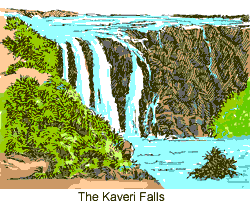
Dimdima
Online Children's Magazine from India

Dimdima
Online Children's Magazine from India
About 25 km north of Talakadu, the Kaveri forms the second major island on its course - Shivasamudram. A tributary named Shimsha joins the Kaveri here. The temple to Ranganatha or Vishnu is called Madhyaranga. The densely-forested island, which is 4.8 km long and 1.2 km wide, can be reached from the mainland by the 474-m-long Lushington Bridge, an arched stone bridge which is more than 150 years old.  The Kaveri encircles the island, the two branches of the river plunging down a height of about a hundred metres. The western branch of the river tumbles down a gorge from a height of 90 m (the Gagana Chukki) and the eastern branch has a descent of 69 m (Bhara Chukki). The Kaveri Falls, as the two cataracts are known, are situated amidst a lush, verdant landscape which makes it an enchanting spot for picnickers and tourists alike.
The Kaveri encircles the island, the two branches of the river plunging down a height of about a hundred metres. The western branch of the river tumbles down a gorge from a height of 90 m (the Gagana Chukki) and the eastern branch has a descent of 69 m (Bhara Chukki). The Kaveri Falls, as the two cataracts are known, are situated amidst a lush, verdant landscape which makes it an enchanting spot for picnickers and tourists alike.
Shivasamudram holds the distinction of being the site of India's first hydro-electric power station built in 1902. It was set up mainly to supply power to the Kolar goldmines 147 km away, making the 78 kv transmission line the longest in the world at the time. In fact, when the Mettur dam in Tamil Nadu was being constructed in the 1930's , the power was supplied from Shivasamudram. The place where the power station is located is called the 'Bluff', literally meaning a cliff with a broad, perpendicular face. The 135-m high bluff was ideal for laying the hydraulic pipes feeding the turbines in the generator. The station itself is named after K.Seshadri Iyer, the Dewan of Mysore from 1883-1901, during whose tenure the hydel project was implemented. The total capacity of Shivasamudram is 42,000 kw. Visitors can travel a dizzying 435 m down in a trolley and see the the working of the station.
The grandeur of the Gagana Chukki falls can be best viewed from behind the tomb or dargah of the Muslim savant Peer Haibe, which glistens like a jewel in the lap of green around it. The Shimsha hydel station is also visible from here. The two arms of the Kaveri unite once more at Sathegala in the north-east.
Last updated on :11/3/2003
Dimdima is the Sanskrit word for ‘drumbeat’. In olden days, victory in battle was heralded by the beat of drums or any important news to be conveyed to the people used to be accompanied with drumbeats.
Bharatiya Vidya Bhavan
K. M Munshi Marg,
Chowpatty, Mumbai - 400 007
email : editor@dimdima.com
Bharatiya Vidya Bhavan
505, Sane Guruji Marg,
Tardeo, Mumbai - 400 034
email : promo@dimdima.com
Dimdima.com, the Children's Website of Bharatiya Vidya Bhavan launched in 2000 and came out with a Printed version of Dimdima Magazine in 2004. At present the Printed Version have more than 35,000 subscribers from India and Abroad.